Nan Hua High School
| Nan Hua High School 南华中学 Sekolah Tinggi Nan Hua | |
|---|---|
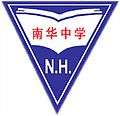 | |
 | |
| Address | |
|
41 Clementi Avenue 1, Singapore 129956 | |
| Coordinates | 1°18′30″N 103°46′09″E / 1.308381°N 103.769167°ECoordinates: 1°18′30″N 103°46′09″E / 1.308381°N 103.769167°E |
| Information | |
| Type |
Government Co-educational Special Assistance Plan (SAP) Autonomous |
| Motto |
忠孝仁爱、礼义廉耻 (Loyalty, Filial Piety, Humanity, Love, Courtesy, Righteousness, Integrity, Sense of Shame) |
| Established | 14 June 1917 |
| Founder | Mr Xiong Shangfu |
| Session | Single-Session |
| School code | 3047 |
| Chairman | Dr Leong Heng Keng |
| Principal | Mrs Tan Jong Lek |
| Enrolment | approx. 1250 |
| Colour(s) | Red Blue White |
| Website | nanhuahigh.moe.edu.sg/ |
Nan Hua High School (NHHS) (simplified Chinese: 南华中学; traditional Chinese: 南華中學; pinyin: Nánhuá Zhōngxué) is a co-educational government secondary school in Clementi, Singapore, offering the four-year Express course leading to the Singapore-Cambridge GCE Ordinary Level national examination.[1][2]
Founded in 1917, Nan Hua High School is the tenth Special Assistance Plan (SAP) school in Singapore, and is an autonomous school since 2001.[3][4] The school is also the West Zone Centre of Excellence for Chinese Language and Culture.[5] Nan Hua High School is not affiliated with Nan Hua Primary School, despite a shared heritage.[6]
History
Nam Wah Girls' School (1917-1955)
_at_Adis_Road.jpg)
Nan Hua High School was founded on 14 June 1917 as Nam Wah Girls' School (simplified Chinese: 南华女学校; traditional Chinese: 南華女學校), by Xiong Shangfu, an overseas Chinese industrialist and prominent figure in the local Cantonese ethnicity. [7] The school was established with the aim to give girls in Singapore the opportunity of receiving an education which was a privilege few girls had at that time.[8] It was first founded in a makeshift school with two rented shop-houses converted into four classrooms in Coleman Street.[8] From a cohort of fewer than 100 Chinese girls, the student population grew rapidly and in 1921, the school moved to a new building in Bencoolen Street to accommodate its expansion. However, in 1924, the school was forced to close temporarily due to financial difficulties. After a series of public appeals, contributions of funds from the community helped pay off the school's debts, and the school re-opened.[9]
By 1928, the Basic Teacher Training Programme had started and the student population continued to grow, leading to a space constraint. In 1941, a new school building at Adis Road was ready and it became the "Main School" that ran normal training classes for teachers alongside primary classes. The old building at Bencoolen Street continued to function as a branch school offering primary classes. That same year, Nan Hwa Girls' School was forced to cease operations as a Japanese invasion drew near. The school complex at Adis Road was turned into the headquarters for the Imperial Japanese Army shortly after the surrender of the British colonial forces.[3]
The school re-opened in October 1945 after the return of the Allied forces. The School Management Committee (SMC) set out to raise funds to rebuild the school and enrol students. Due to the overwhelming financial support of many parents, secondary classes were set up and the school's enrolment rose to 700 pupils.
Nan Hwa Girls' High School (1956-1984)
_at_Bencoleen_Street.jpg)
The school's name was changed to Nan Hwa Girls' High School in 1956. During this period, the curriculum underwent much restructuring and the school emerged as one of the premier girls' schools in Singapore. The branch school was separated from the main school to function as a primary school, with its name changed to Nan Hwa Primary School (current Nan Hua Primary School).[8] The Main School became a secondary school after it terminated the intake of primary pupils in 1964.[3]
Restructuring as a Government School (1984-2000)
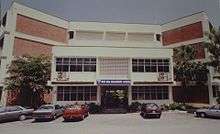
On 12 December 1982, Nan Hwa Girls' High School moved from Adis Road to Clementi Avenue 1 on the recommendation of the Ministry of Education (MOE). The school began to admit Secondary One boys and thus became coeducational in 1984. The school was also renamed as Nan Hua Secondary School, dropping the word "girls" in its name to reflect the change.
On 1 April 1986, the School Management Committee was dissolved and the school administration was handed over to the Ministry of Education, while the School Advisory Committee was formed to represent the interest of the school. This signified the change of the school from a Chinese medium school to an integrated secondary school that incorporated English as the medium of instruction.[10] The move also ended the school's long-standing status as an aided school.[3]
Attainment of SAP Status (2000-present)
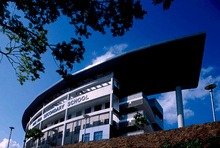
In the new millennium, Nan Hua Secondary School was accorded as the 10th Special Assistance Plan school. Under the Programme for Rebuilding and Improving Existing Schools (PRIME), the school was relocated to a new campus built at the adjacent 41 Clementi Avenue 1 on 20 December 2003. The former premises was reoccupied by the NUS High School of Math and Science. The school subsequently attained the School of Distinction Award and Singapore Quality Class Award in 2005. The new school building was officially opened by Prime Minister Lee Hsien Loong on 17 July 2005 when he declared Nan Hua Secondary School achieving its Autonomous Status in 2006. The school's name was changed to Nan Hua High School from 1 January 2006.[3]
In 2010, Nan Hua High School received the President's Award for the Environment, the highest environment accolade for organisations and companies in Singapore.[11] In 2017, Nan Hua High celebrated its 100th Anniversary with a series of activities and celebrations throughout the year, culminating in the 100th Anniversary Dinner held on 15 July 2017.[12]
Principals
| Name of Principal | Native Name | Years Served |
|---|---|---|
| - Unknown - | - 未详 - | 1917 - 1941 |
| Mdm. Yang Shui Chor[13] | 杨瑞初女士 | 1945 - 1971 |
| - Unknown - | - 未详 - | 1971 - 1974 |
| Mdm. Tsao Yu Hang[13] | 曹玉航女士 | 1974 - 1978 |
| - Unknown - | - 未详 - | 1979 - 1992 |
| Mrs. Leong Kum Hoong[13] | 梁昆宏女士 | 1992 - 1993 |
| Mr. Loh Leong Beng[13] | 骆良明先生 | 1998 - 2003 |
| Dr. Foo Suan Fong[13] | 符传丰博士 | 2003 - 2009 |
| Mrs. Tan Jong Lek[13] | 洪葆女士 | Dec 2009 - To date |
School identity and culture
School Crest
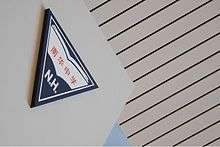
The white colour of the school crest embodies purity in thought, word and deed. The blue signifies essential qualities of good character, namely sincerity and integrity. The three corners of the triangle, a distinct feature for many Chinese schools, represents the moral, intellectual and physical developments of students.[14] The widely opened book featured in the crest symbolises the school's virtue in education.[15]
School Song
The school song is made up of two verses, one in English and one in Mandarin Chinese.[16] In every rendition of the school song, both verses are sung, with the English verse coming first, followed by the Mandarin verse. The verse in English are written by Miss Ho Lai Lin, and the song was moderated by Chin Wai Fah.[17] Nan Hua High School and Nan Hua Primary School have similar school songs, due to the shared heritage of both schools.[18]
Attire and Appearance
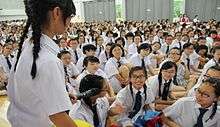
The school uniform is a white shirt with two metal buttons at the shoulder, with the Traditional Chinese characters of the school name on it. Boys wear shirts with two front pockets at the chest fastened with two metal buttons, and it is also known as a studded shirt in the school's official website. Both shirts for boys and girls feature two shoulder flaps on each side, a unique feature of traditional Chinese schools. Traditional Chinese schools award ranks to students according to their achievement and seniority, and these shoulder flaps are used to hold epaulets denoting their ranks, much like military uniforms. The traditional Chinese schools have since abolished this system, and the shoulder flaps serve no major purpose. However it is still retained as it symbolises Nan Hua's roots as a traditional Chinese school.[16]
In Nan Hua High School, girls with long hair have to tie their hair into two scorpion or French plaits. This is a practice rare among Singapore schools, and thus plaits are a unique part of Nan Hua's culture and is often associated with the school itself.[19]
School Events
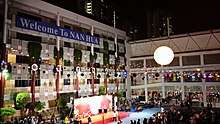
As a Special Assistance Plan school, Nan Hua High School observes traditional Chinese festivals such as the Chinese New Year and the Mid-Autumn Festival through annual school events that are attended by students, staff and alumni. Other notable school events include Camp Achiever, a collection of camps attended by all four levels of the school cohort at the start of the year, as well as the annual Road Run and Sports Carnival.
Campus

Nan Hua High School's current campus lies on 292,710 square feet (27,194 m2) of hill land at 41 Clementi Avenue 1.[20] It consists of an admin & aesthetics block, a science block, a canteen & hall block, three classroom blocks, a foyer, an indoor sports hall, a parade square, an eco-garden and a field.
The administration & aesthetics block mainly houses the general office, staff room and dedicated rooms and studios for the Performing Arts CCAs. A sky garden, a classroom based on an "open classroom" concept on the 5th floor of the same block was opened by then Minister for Education, Tharman Shanmugaratnam on 25 April 2007. The sky garden was the culmination of a variety of proposals put forth by students after a challenge issued to them by then Principal Dr Foo Suan Fong to come up with ideas to transform the space into one which could be used not only for casual meetings, but also for lessons and CCAs.[21] The auditorium, named after the school's top donor, the Yeung Ching Foundation, is also located on the same level as the sky garden.
 Campus entrance
Campus entrance Front facade of the Admin & Aesthetics Block
Front facade of the Admin & Aesthetics Block.jpg) Rear facade of the Admin & Aesthetics Block
Rear facade of the Admin & Aesthetics Block Eco-Garden
Eco-Garden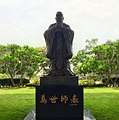 Statue of Confucius at the car porch
Statue of Confucius at the car porch Science Block, with the Parade Square in the foreground
Science Block, with the Parade Square in the foreground View of Nan Hua High School from Clementi Road
View of Nan Hua High School from Clementi Road
Academic information
O Level express course
Nan Hua High School offers the four-year Express course which leads up to the Singapore-Cambridge GCE Ordinary Level national examination. To build cross-cultural capabilities in a multi-racial society, Nan Hua also offers promising students the opportunity to study Malay under the Malay Special Programme (MSP).[22]
Academic subjects
The examinable academic subjects for Singapore-Cambridge GCE Ordinary Level offered by Nan Hua High School for upper secondary level (via. streaming in secondary 2 level), as of 2017, are listed below.
Notes:
- Subjects indicated with ' * ' are mandatory subjects.
- All students in Singapore are required to undertake a Mother Tongue Language as an examinable subject, as indicated by ' ^ '.
- "SPA" in Pure Science subjects refers to the incorporation of School-based Science Practical Assessment, which 20% of the subject result in the national examination are determined by school-based practical examinations, supervised by the Singapore Examinations and Assessment Board. The SPA Assessment has been replaced by one Practical Assessment in the 2018 O Levels.
Science
- Additional Mathematics*
- Mathematics*
- Physics (SPA)
- Chemistry (SPA)*
- Biology (SPA)
Language & Literature
- English Language*
- Chinese Language* ^
- Higher Chinese Language
- Malay (Special Programme)
Humanities
- Geography
- History
- Combined Humanities (Social Studies & History Elective/Geography Elective)*
Arts & Aesthetics
- Art & Design
- Design & Technology
- Food & Nutrition
SAP Flagship Programme
The SAP Flagship Programme (a programme offered at SAP schools) at Nan Hua High School is revolves around Chinese Culture and Bi-cultural Studies. Being the only SAP high school directly under the government, the programme is fully governed under the Ministry of Education, as opposed to independent and government-aided schools.[23]
The flagship programme comprises two elements and five key components. The elements of classical thoughts and culture is brought forth through appreciation of Chinese Culture as well as Confucianism ideals. The programme also covers life-skills such as translation.
Alumni
Nan Hua Alumni Association
Nan Hua Alumni Association was established in 1998, as a platform to reconnect alumni and preserve the school spirit. Nan Hua. The alumni body is made up of two wings, the main wing and the youth wing.[24]
Notable alumni
- Andie Chen: Actor
- Ashley Isham: Fashion designer
- He Ying Ying: Actress, Mediacorp
- Hong Junyang: Singer and host; Runner-up, Project SuperStar 2005
External links
References
- ↑ "Secondary School Courses, Ministry of Education, Singapore". Archived from the original on 8 September 2015.
- ↑ pg. 206, Choosing Your Secondary Schools, Part Two: Information on Secondary Schools (2010), Ministry of Education, Singapore
- 1 2 3 4 5 "Our History, Nan Hua High School". Archived from the original on 27 September 2015. Retrieved 20 September 2015.
- ↑ "pg. 8, Secondary School Education: Shaping the Next Phase of Your Child's Learning Journey, Ministry of Education, Singapore" (PDF). Archived from the original (PDF) on 30 October 2012.
- ↑ "Our Niche, Centre of Excellence for Chinese Language and Culture, Nan Hua High School". Archived from the original on 29 September 2015. Retrieved 20 September 2015.
- ↑ "Symbol of Heritage, Nan Hua Primary School". Archived from the original on 22 December 2015. Retrieved 2 October 2018.
- ↑ 区, 如柏 (1999-07-29). "南华经验可供南侨借鉴". 联合早报. Singapore Press Holdings. Retrieved 2017-12-22.
也是从女校发展起来的南华中学与南华小学的情况可不同了。南华是广东人创办的学校,具有82年的历史,在1983年之前,南华女中的校址在爱蒂丝路,南华小学则在明古连街。从70年代中开始,因受市区重建的影响,小坡一带的居民减少,南华学生人数锐减。到了80年代初,南华董事会决定学校搬迁,由当时的南华中学校长曹玉航负责和教育部接洽安排搬迁的工作。
- 1 2 3 hermes (10 July 2017). "100 years of Nan Hua through the eyes of alumni". The Straits Times. Archived from the original on 13 September 2017. Retrieved 13 September 2017.
- ↑ "Our Roots, The Nan Hua Route: Founding of Nan Hua High School". Archived from the original on 28 December 2013. Retrieved 27 December 2013.
- ↑ "立国大计须百年树人 南华同人以此自克励". www.redants.sg. Archived from the original on 13 September 2017. Retrieved 13 September 2017.
- ↑ "Ministry of Education, Singapore: Speeches - Speech by Mr Heng Swee Keat at Nan Hua High School's 95th Anniversary Dinner". Archived from the original on 31 December 2013.
- ↑ hermes (25 April 2017). "Nan Hua marks 100 years of education". The Straits Times. Archived from the original on 12 October 2017. Retrieved 12 October 2017.
- 1 2 3 4 5 6 "Nan Hwa Girls' High School at Adis Road, circa 1966 - BookSG - National Library Board, Singapore". eresources.nlb.gov.sg. Archived from the original on 13 September 2017. Retrieved 13 September 2017.
- ↑ Zhuang, Justin (2013). Singapore School Crests - The Stories Behind the Symbols (PDF). Singapore: National Library Board. p. 21. ISBN 978-981-07-6524-8. Archived (PDF) from the original on 13 May 2015. Retrieved 24 October 2016.
While the crest's shape signified the three-way link between the school's board members, teachers and students of Chinese High, school crests from Nan Hua High and Chung Cheng High used the triangle to symbolise the moral, physical and intellectual development of their students. Another Chinese school, Nan Chiau High, also sought to express this, but with three interlocking rings instead.
- ↑ pg. 3, School Crest, Nan Hua High School Student Handbook 2013
- 1 2 "Our Roots, The Nan Hua Route: Nan Hua School Culture". Archived from the original on 28 December 2013. Retrieved 27 December 2013.
- ↑ pg. 5, School Song, Nan Hua High School Student Handbook 2013
- ↑ "School Song, Nan Hua Primary School". Archived from the original on 27 May 2012. Retrieved 2 October 2018.
- ↑ pg. 35, School Rules and Regulations, Nan Hua High School Student Handbook 2013
- ↑ "Where to Find Us, Nan Hua High School". Archived from the original on 9 May 2015. Retrieved 20 September 2015.
- ↑ "Speech by Mr Tharman Shanmugaratnam, Minister for Education and Second Minister for Finance, at the Launch of the 90th Anniversary Celebrations of Nan Hua High School cum Official Opening of the "Sky Garden"". Archived from the original on 22 May 2012. Retrieved 30 December 2013.
- ↑ "Schools & Centres Offering Higher Mother Tongue, Chinese (Special Programme) & Malay (Special Programme)" (PDF). Archived from the original (PDF) on 24 October 2013.
- ↑ "SAP Flagship". nanhuahigh.moe.edu.sg. Archived from the original on 13 September 2017. Retrieved 13 September 2017.
- ↑ "About Us | Nan Hua High School Alumni Association". nhalumni.herokuapp.com. Archived from the original on 13 September 2017. Retrieved 13 September 2017.